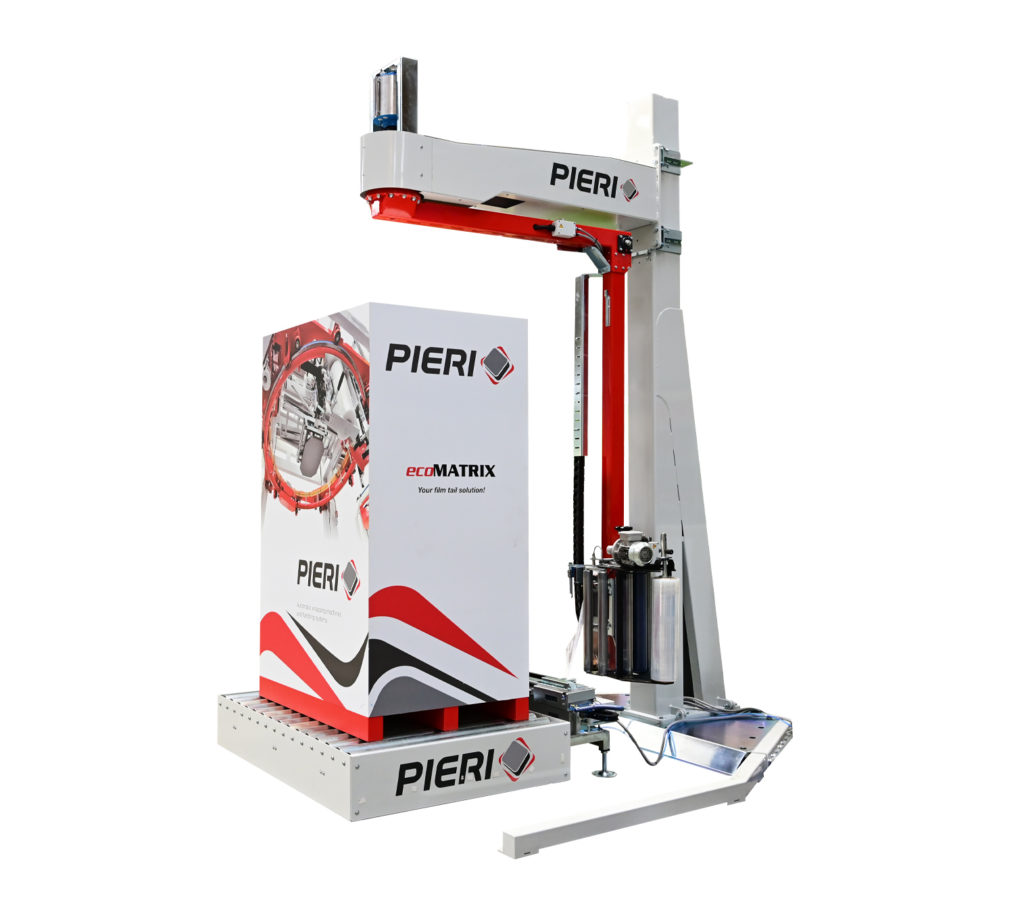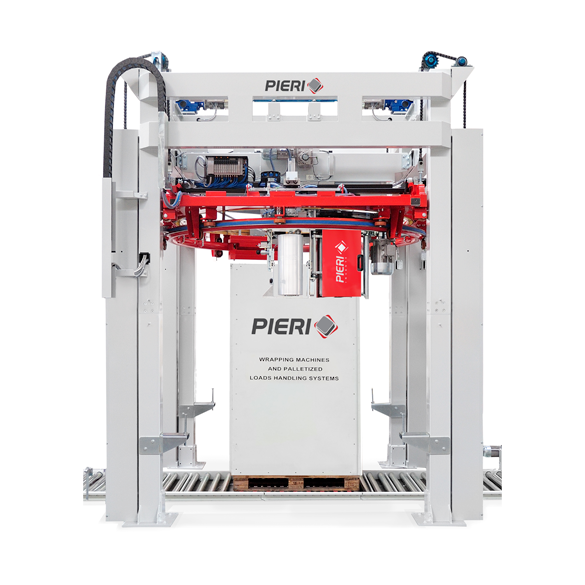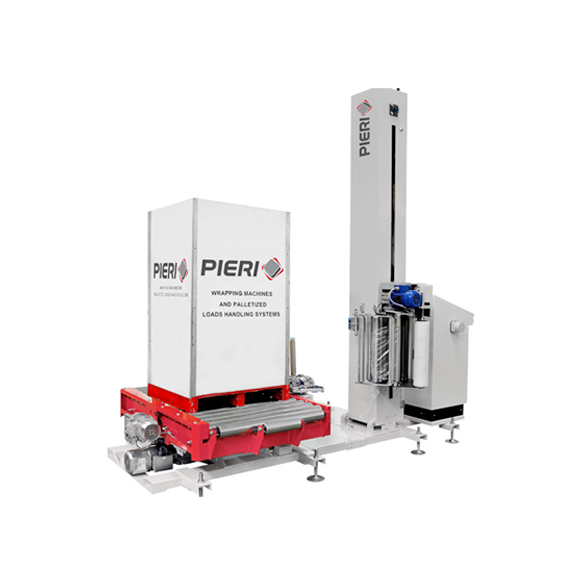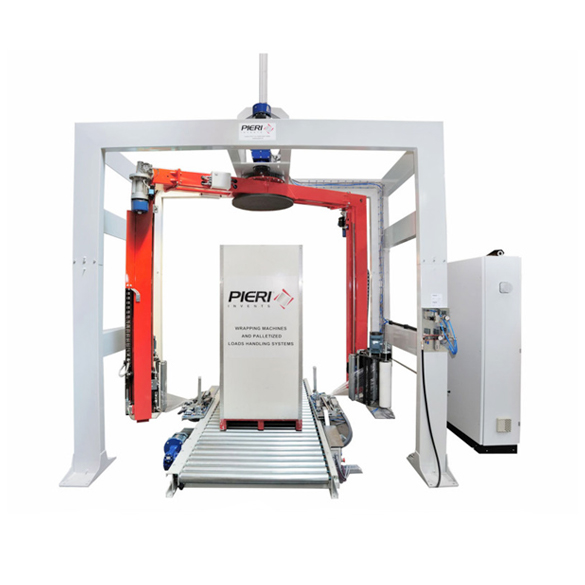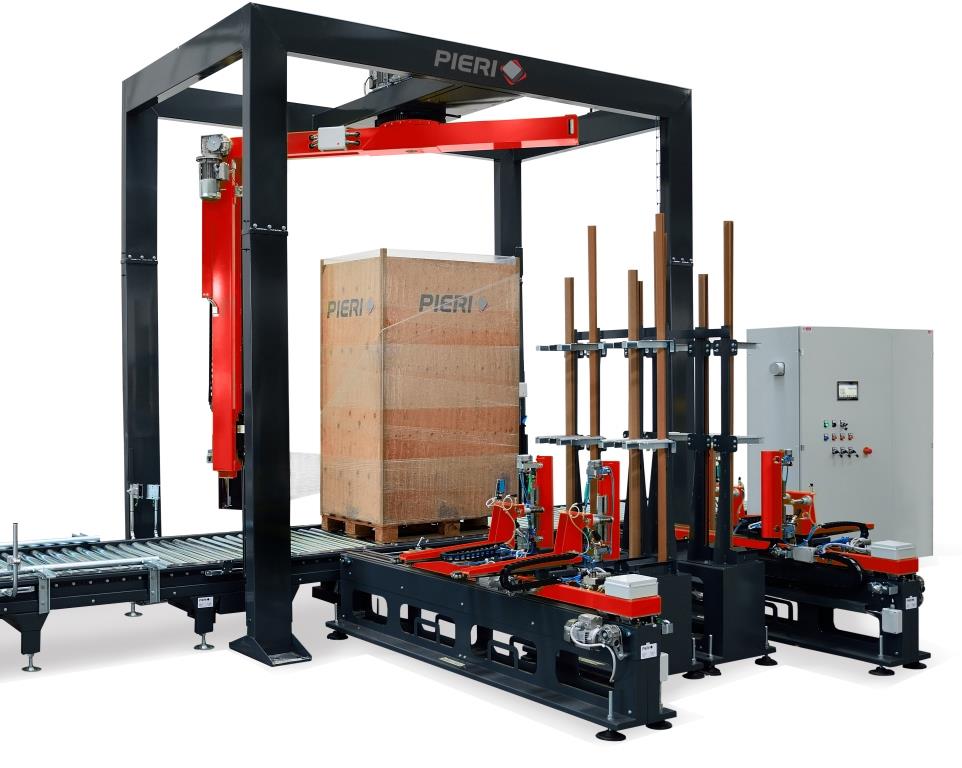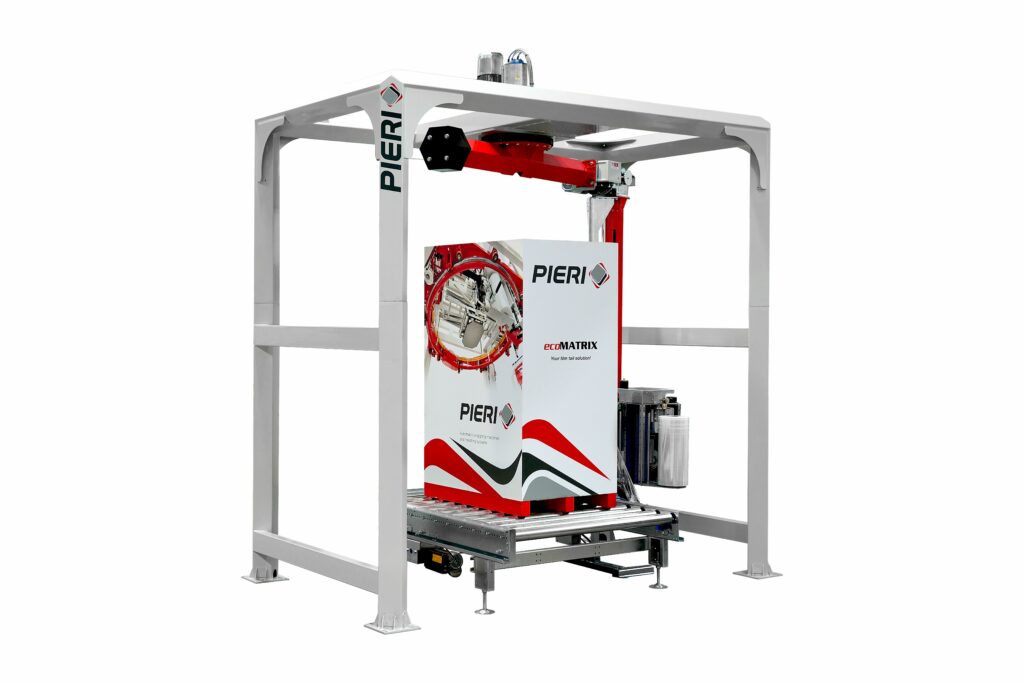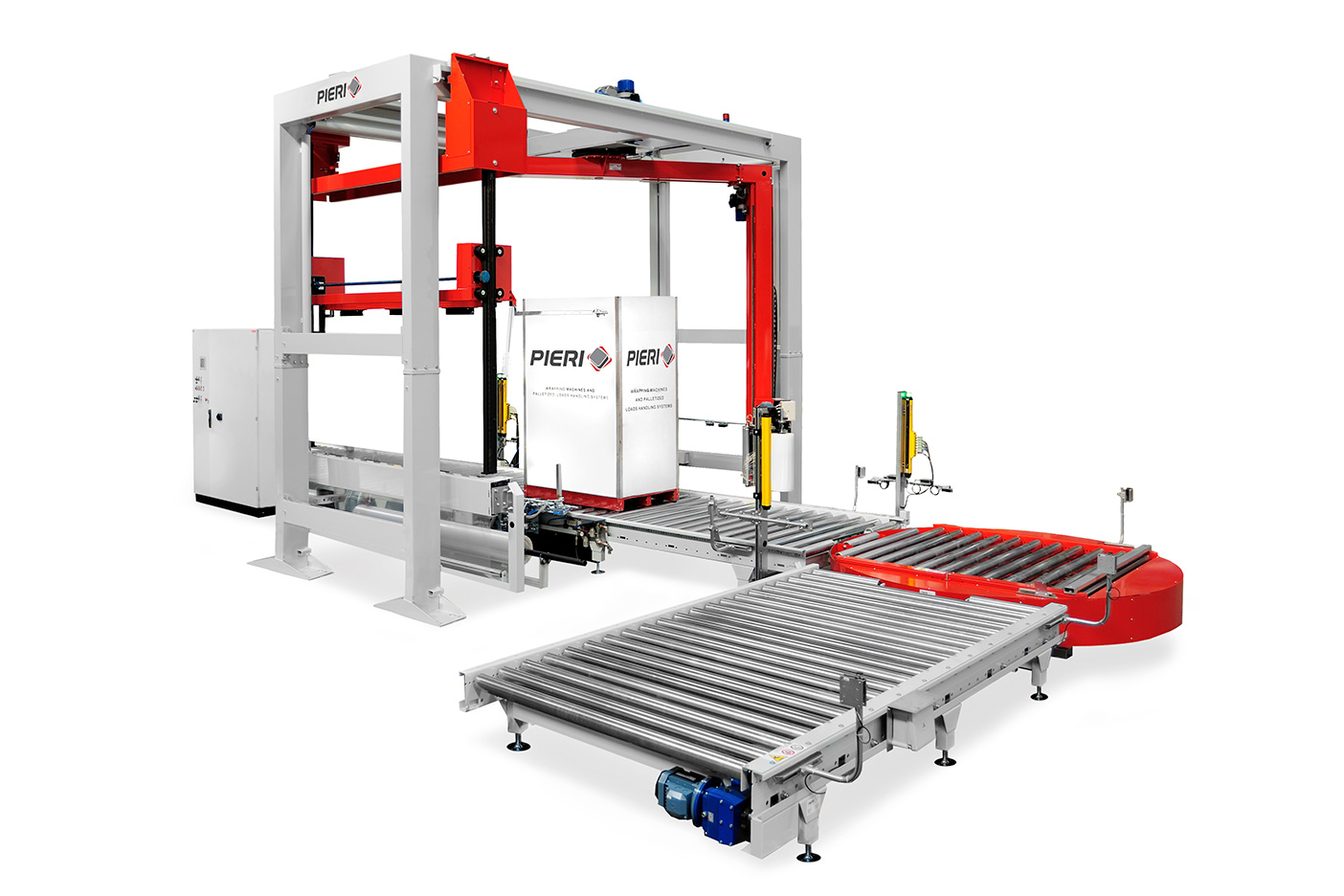
Stretch wrappers: the definitive guide to choose the right model for your company
Stretch wrap machines wrap loads and products vertically or horizontally by means of a roll of stretch film that protects and stabilises them.
Vertical stretch wrappers cover packages placed on pallets, while horizontal stretch wrappers also cover products such as boards, pipes, and sheets. We will talk more about this distinction later in this text (and in particular about automatic wrappers).
In both cases, the number of stretch film spins depends on the type of wrapper.
A Pieri automatic turntable stretch wrapper, for example, is a machine suitable for companies that have little warehouse space. By default, it provides six complete spins of final wrapping both at the top and at the bottom on the pallet end points, followed by a film tensioning phase.
The wrapping process takes place by means of a motorised carriage that brings the palletised load closer to the machine, followed by the descent of a hydraulic arm locking it. This triggers the table rotation, which can reach 30 p/h.
The spiral pitch (wrapping factor) is adjusted automatically and measured by the ratio between the speed of the carriage going upwards and the travel speed of the wrapper.
Why buy an automatic stretch wrapper?
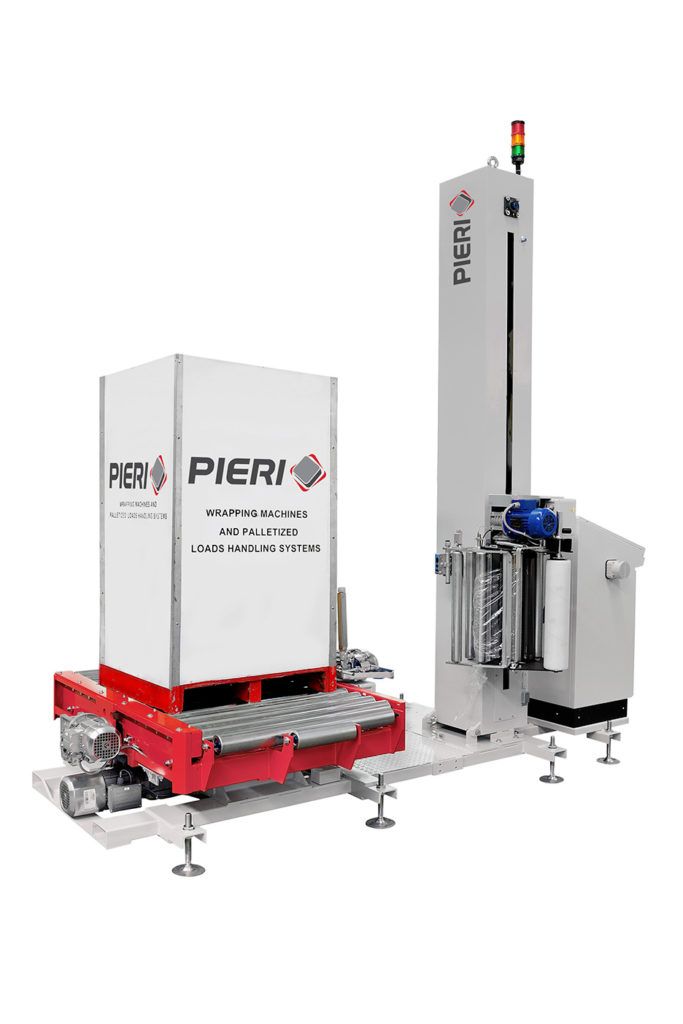
The companies that can obtain advantages from the purchase of stretch wrappers are those companies with a warehouse or those operating in the warehouse inventory management.
Without further ado, the purchase of a packaging machine is a good choice for:
- reducing the use of stretch film (an automatic wrapper is able to stretch a polyethylene film by 400% its original length compared to the 10/20% if the operation is carried out manually by an operator);
- reducing warehouse labor costs (instead of having an employee wrap the pallet 20 times, an automatic wrapper, such as those sold at Pieri, is able to do so also 50 times in a 1/10 of the time, allowing you to employ your machine operator, your mechanical maintainer, your electrical maintainer, or your manufacturer’s technician in other tasks);
- reducing training costs and accidents (it may seem a simple operation, but wrapping a pallet manually requires staff training, which an automatic wrapper needs not);
- reducing warehouse space (an already wrapped pallet can be immediately sent for storage, freeing warehouse space);
- improving inventory control (wrapping pallets with well-applied stretch film allows you to place stickers on them with a scannable code useful for inventory control operations);
- eliminating the risk of film tearing and damage to the packaged material (a pallet that is wrapped and sent for storage does not run the risk of being torn during the most common warehouse activities, such as clashes between forklifts);
- standardising the wrapping process (automating the wrapping process allows you to standardise the output of the operation, keeping the same final result also from the point of view of the look)
- reducing the number of returns (thanks to the use of wrapping machines, the packaging will be protected more effectively, drastically decreasing the number of returns due to accidental breakages during the transportation of the product).
Things to consider before buying a wrapper
The purchase of a wrapping machine should be well thought out, because its purchase price varies between € 5.000 and € 30.000.
In case you wish to call a salesperson to ask for advice, we suggest that you gather the following information:
- how many pallets do you pack per hour? how many per shift or per day?
- do you think you need a manual, semi-automatic, or automatic wrapper? The decision depends on your answer to these questions. To give you a reference, an automatic wrapper wraps 10 pallets per hour, source Wikipedia;
- what are the dimensions of your pallets (width x length x height)?
- what is the weight of your pallets?
- do you need a vertical or horizontal packaging?
- do you work with stable or unstable goods?
- do you have any special requirements you want the packaging to have? For example, tape thickness, wrapping density, etc.?
The most common types of wrapper
There are many types of wrapping machines that use special films (usually, polyethylene is used).
The first possible distinction is between manual wrappers, semi-automatic wrappers – those present at airports for wrapping travelers’ suitcases – and automatic wrappers.
Please forgive us if we focus only on the latter, as we at Pieri are experts in automatic packaging machines.
The automatic wrappers are machines that do not require the intervention of an operator – they wrap the palletised load with a frequency of even a dozen pallets per hour.
A further distinction exists between horizontal automatic wrappers and vertical automatic wrappers.
The automatic vertical wrappers are useful for coating height-developed palletised products, products with reduced thickness or circumference; products that require an end to end wrapping.
The automatic horizontal wrappers, on the other hand, are used to wrap rectangular or square-shaped palletised products along their entire length.
Automatic vertical wrappers include:
-
-
- rotating arm wrapping machines, with this type of packaging machine, the load is immobile, because it is the rotating arm that turns around it, unwrapping the stretch film over its entire surface,
- rotating arm wrapping machines, with this type of packaging machine, the load is immobile, because it is the rotating arm that turns around it, unwrapping the stretch film over its entire surface,
-
-
- rotating ring wrapping machines, even with this type of packaging machine, the load is immobile in the wrapping area but it is a rotating ring that wraps it over its entire surface.
- rotating ring wrapping machines, even with this type of packaging machine, the load is immobile in the wrapping area but it is a rotating ring that wraps it over its entire surface.
-
- rotating turntable wrapping machines even with this type of wrapping machine, the pallet, once blocked on the motorised pre-stretch carriage, is wrapped as the turntable rotates, thanks to a system with a toothed thrust bearing and a gear motor controlled by an inverter.
- rotating turntable wrapping machines even with this type of wrapping machine, the pallet, once blocked on the motorised pre-stretch carriage, is wrapped as the turntable rotates, thanks to a system with a toothed thrust bearing and a gear motor controlled by an inverter.
Summary of what to consider when choosing a stretch wrapper
Now that you have clearer ideas about the type of packaging machine you need, we want to list you some features that you need to consider for your next wrapping machine:
- the whole operation of a packaging machine depends on the heat tunnel, which makes the plastic film shrink. This heating function is often defective in used stretch wrappers, so check it before purchasing the machine;
- the machine should use the least possible amount of film to stabilise the palletised load;
- the stretch wrapper should ensure a solid and resistant wrapping;
- the stretch wrapper should offer the possibility to adjust the tension of the film on the palletised load;
- the machine should ensure an easy replacement of the polyethylene roll and of the thrust bearing lubrication;
- the after-sales service. Even if these machines are not likely to break frequently, it is important that the company selling you the wrapper acts promptly to reduce the machine downtime.

